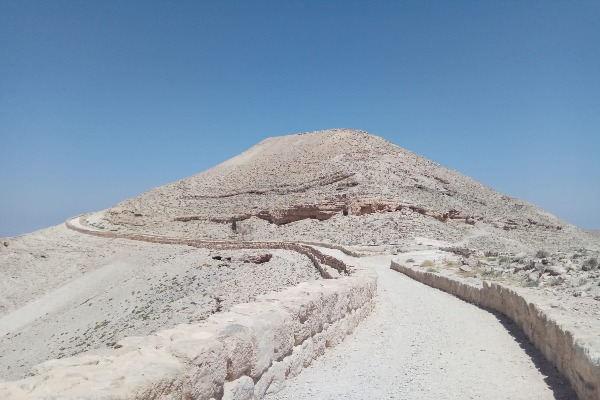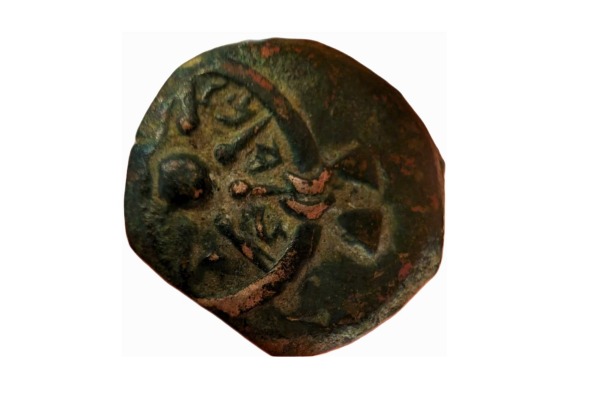Forgotten Dead Sea archaeological site possibly used by John the Baptist and Herod Antipas
Royal boat dock on the Dead Sea may have been used to transport John the Baptist

On the side of Israel's Highway 90, between the road and the Dead Sea, lies a fascinating but neglected historical site.
"Metzad Kidron" in Hebrew, or “Khirbet Mazin” in Arabic, is located south of the Einot Tzukim Nature Reserve, near the Israeli settlement of Ovnat on the western shores of the Dead Sea, in modern-day Judea (West Bank).
This unusual site was probably used as a boat dock by King Herod Antipas and other monarchs to sail to different locations, such as the Machaerus Fortress on the eastern side of the Dead Sea.
The remarkable fortified boat dock dates to the Hasmonean period, demonstrating that the Dead Sea served as a crucial transportation route between Judea on the western shores of the Dead Sea and Moab, on its eastern shores, during the late Hellenistic and early Roman periods (2nd and 1st centuries B.C to 1st century A.D). in the Holy Land.

The site uniquely combines a fortress tower, a dry dock and a boat dock within a single structure. The structure's walls, preserved to a height of 5 meters (16 feet) are even visible today from Israel's Highway 90.
As a part of the eastern fortification line of the Jewish Hasmonean Kingdom, Metzad Kidron historically sat very close to the waterline, with access through a large sea-facing opening. The fortress complex comprises a tower, a shipyard, ramp and pier.
The rectangular tower, measuring 18 meters (60 feet) long and 9 meters (about 30 feet) wide, contained a double water cistern capable of holding nearly 30 cubic meters of water, as well as two deep storage rooms accessible by wooden ladders.
It is believed that the tower had three floors, each with about six rooms used by the fortress guards. Additionally, the massive tower served as a residence for workers and royal guests.

Built on a natural slope facing east toward the Dead Sea, the shipyard measured 30 meters (100 feet) in length and 11 meters (36 feet) in width. A ramp within the shipyard facilitated the hauling of ships out of the water for maintenance and repairs, which included intensive washing to remove the Dead Sea's aggressive salts with fresh water.
The high concentration of minerals and salts in the Dead Sea remains a significant challenge for ship maintenance even today. Throughout history, this has deterred many from using the Dead Sea as a navigation route due to the rapid deterioration it causes to wooden and metal boat hulls.
Adjacent to the ramp was a 15-meter (50-foot) long pier made of stone and used for docking boats to load and unload cargo. This pier served as a regular dock for vessels coming from the eastern shore of the Dead Sea.
Archaeologist Pesach Bar-Adon conducted excavations at the site and proposed an identification with Midin, an ancient city mentioned in the territory of the tribe of Judah (Joshua 15:61). He suggested that the fortress originally served as a strategic stronghold, securing crossroads linking the Transjordan with major desert routes.
Dating back to the reign of Uzziah, King of Judah (8th century B.C.), the fortress fell into disuse after the destruction of the First Temple. During the Hasmonean era, the site underwent reconstruction and expansion and transformed into a vital dock facility for navigating the Dead Sea, serving trade routes that circumvented the treacherous cliffs of Rosh Tzukim (Ras Feshkha).
Archaeologist Yizhar Hirschfeld believed that King Alexander Jannaeus used this as a royal dock. From here, luxury ships would set sail to destinations such as Machaerus, Ein Gedi or Masada.
Additionally, ships departing from this dock collected blocks of asphalt floating on the water, which were traded with surrounding countries, thereby enriching the Hasmonean state's treasury. Plinius the Elder referenced the phenomenon, and writers wrote about the many Roman tourists who visited for the therapeutic benefits of the Dead Sea during antiquity.

Archaeological findings at the site include pottery from the Second Israelite period (8th-7th centuries B.C.) and the Hellenistic and Roman periods (2nd century B.C. to 1st century A.D.), as well as a large bronze coin hoard from the time of Alexander Jannaeus and many other coins from Hasmonean and later periods, up to the First Jewish Revolt of 66 to 74 A.D. against the Romans.
The hoard, studied years ago by the numismatist Dr. Donald Tzi Ariel, was discovered near the boat dock in an area submerged during the 1st century B.C. and A.D., suggesting that the hoard may have fallen from a ship or been intentionally thrown. The exact reasons behind its placement remain a mystery.
Most of these coins associated with Alexander Jannaeus are of the type known as "anchor and star coins," with one side depicting an anchor with the inscription "coin of King Alexander," while the other side features an 8-pointed star with the inscription "King Jonathan," the Jewish name of Jannaeus, between the points. According to some archaeologists, these coins may signify originally the king's maritime activities in the Dead Sea region.

However, we know that this specific coin type, also known as "the widow's mite," continued to be used long after the life of the famous Hasmonean king. The coin served as a kind of emblem or brand that was minted for a considerable period after the King's death. Some scholars identify poorly designed types of this coin as those minted during Jesus' time and many years following Jannaeus's death. It may be possible that the hoard was lost or thrown away from a ship a long time after Jannaeus, perhaps during the time of John the Baptist and Jesus.

Archaeologist Professor Ehud Netzer, also argued that Metzad Kidron housed a luxurious royal structure built during the reign of Alexander Jannaeus.
While it is evident that the site primarily developed and took its architectural form during the broader Hasmonean period, it likely continued being used during the Herodian era, possibly even by King Herod and his sons. The dating of archaeological findings supports its ongoing use during this period.
This raises the intriguing possibility of the boat dock's use during the time of Jesus, particularly notable when considering John the Baptist's execution by Herod Antipas at the renowned Machaerus Fortress in modern-day Jordan, on the eastern shores of the Dead Sea. This boat dock, situated on the western shore, may have been frequented by Herod Antipas for journeys to Machaerus, and was conceivably used by John the Baptist for transportation to his place of imprisonment.

During the last few years, as part of the development and preparation of the site for public visits, preservation work was carried out on the unique structure, and a visitor trail was paved with shaded stations along its length.
The enigmatic site may have been frequented by numerous individuals mentioned in both the Old and New Testaments, sparking the imagination as we attempt to piece together hidden historical puzzles.
Metzad Kidron serves as a prime example of these Holy Land sites where, despite lacking direct proof, one might ponder: "Perhaps Jesus, a prophet, or another biblical figure once stood here."

Aaron Goel-Angot is a Belgian-Israeli archaeologist with an expertise in antiquities identification. He is an enthusiastic numismatist and a licensed tour guide. He holds a BA degree in archaeology from the Institute of Archaeology at the Hebrew University of Jerusalem. He joined the ALL ISRAEL NEWS team as an Archaeology and Tourism correspondent. Aaron is married, father of three young children and lives in Jerusalem.
You might also like to read this:













